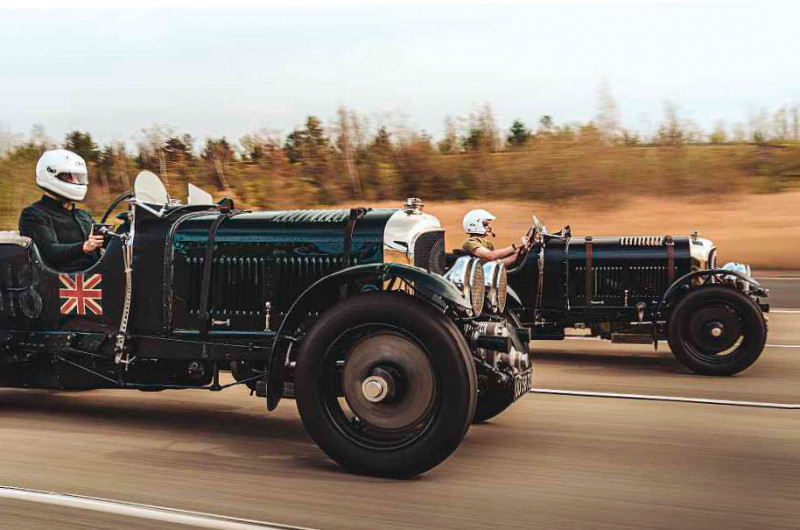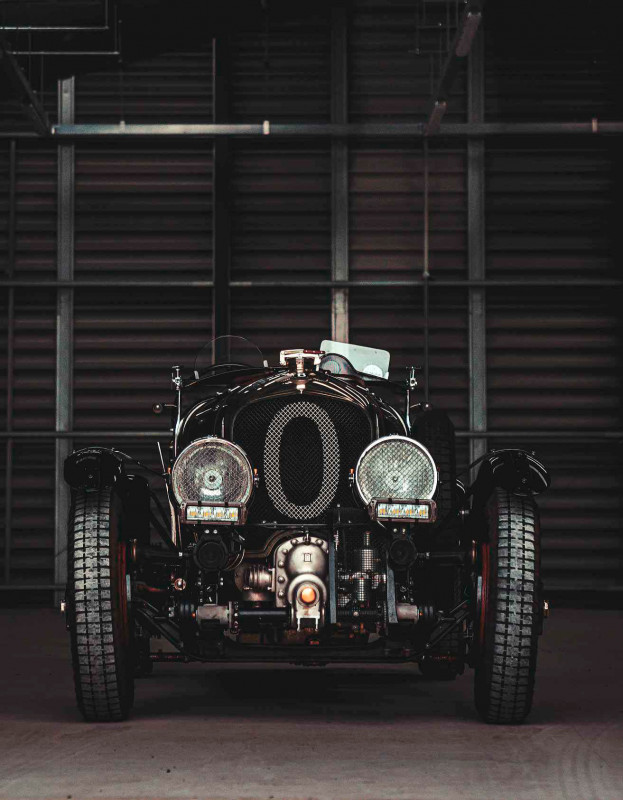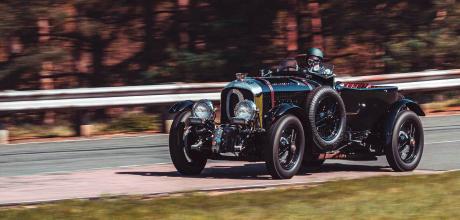2022 Bentley ‘Blower’ Continuation
Bentley is well on the way to completing its batch of a dozen Blower Continuation cars. Mark Dixon compares new and original examples on track.
Photography Mark Riccioni (track), Amy Shore (factory)
BENTLEY BLOWER
Driving the controversial Crewe continuation
Brand new vintage Blower: the whole story

Every one of us remembers our formative motoring encounters. Mine happened more than 30 years ago, when I was overtaken on the M1 by a vintage Bentley stonking along at what must have been (in those less censorious days) a good 90mph. What made it all the more memorable was that the lone occupant was a middle-aged lady, who I’m now convinced was the noted vintage racer Anne Shoosmith. I thought she just looked the coolest person in the world, ever.

That experience comes to mind as I round a banked turn at the Millbrook Test Facility at the wheel of another vintage Bentley, cruising at an easy 70. There is clearly more, much more, in reserve – but that should come as no great surprise, since this particular Bentley is a genuine ‘works’ team car that raced at Le Mans in 1930. While this driver certainly doesn’t look as cool today as Mrs Shoosmith did when she was parting the Sierras and Cavaliers on Britain’s then-busiest motorway, the car is positively sub-zero: it’s Tim Birkin’s personal ‘Blower’ Bentley 4.5-litre, which has been owned by Bentley Motors since 2000.

The reason we’re at Millbrook is because Bentley wants us to compare this most significant of Blowers with a brand-new version, the Car Zero prototype that is the forerunner of the dozen Blower Continuations currently in production. The project was announced back in 2019 and the first customer cars are now being delivered. Bentley had no problem finding buyers very quickly for all 12, and nearly all of them were existing customers keen to experience ownership of a Blower, only 54 of which were built: 50 road cars and four racers.
These cars are exact replicas (with a few very minor concessions to modern attitudes to safety), built by the same company that made the originals; and continuation cars have been a ‘thing’ since Aston Martin and Zagato collaborated to make four brand-new DB4 GT Zagatos in the late 1980s. So Bentley perhaps wasn’t quite expecting the backlash it received from a number of high-profile owners of the originals. An open letter signed by ten of these owners in March 2020 stated: ‘We urge you to please not squander time, funding, energy and the Bentley brand’s reputation upon the recently announced batch of 12 facsimile cars, cars that would serve only to dilute that special admiration and awe that can only come from viewing and embracing the genuine article. To do otherwise would be to pervert a glorious history.’
Strong stuff. Bentley’s people politely chose not to follow their advice – and can you blame them? To the wider world it’s all good brand-awareness PR, and at a best-guess retail price of £1.5m per car the project will more than ‘wash its face’. Whatever your thoughts may be on corporate monoliths dabbling in a world outside their comfort zone, at least Bentley is showing real enthusiasm for its past. So let’s take a trip to Crewe and see just how involved they are with building more Blowers.
Bentley’s factory at Pyms Lane has seen massive expansion during the last few years, with new facilities seemingly being erected left, right and centre. Among them is the Mulliner division that handles Bentley’s special projects and custom-builds, and a portion of its facility has been given over to a Blower production line.
As you’d expect of a Bentley workshop, it’s as clean and tidy as an F1 team’s, all gleaming white surfaces and LED lighting, although the layout is not that dissimilar to the assembly hall in which Bentleys were built at Cricklewood during the 1920s. There are bays marked out on the floor along the right-hand side, each allocated to a Continuation chassis, and Octane’s visit occurs at a unique moment when no fewer than three customer cars are together in different stages of build.
The finished Car Zero is here, too, along with an all-but-completed Blower that’s painted an unusual Dawn Blue rather than the more familiar British Racing Green. The latter is something of a post-war cliché, it seems, because black was actually the most popular vintage Bentley colour when new.
‘We wanted the Continuations to be presented in a narrow, authentic range of colours,’ explains project leader Ben Linde, who has done a vast amount of research since taking on the role. ‘We are offering two shades of green: BRG and a lighter Napier Green, of which we found traces on the team car when it was stripped down. It’s Parsons Paint code 45079-17.
I can’t remember my child’s birthday but I can instantly recall that code!’ But we’re getting ahead of ourselves here. The ex-Birkin team car had been completely dismantled so that it could be 3D-scanned, to compare the physical reality with period works drawings of components. This proved essential, says Ben: ‘The team car was built not by the factory but by Birkin’s mechanics, and we found fairly early on that there were a lot of changes that were not necessarily on record. If we’d made everything from drawings, we’d not have been able to put the Continuations together properly. The knowledge of the guys in the vintage Bentley world was invaluable, too.’
Indeed, Bentley couldn’t have embarked on the Blower Continuation project without the support of outside specialists: a lot of support. The bodies’ ash frames were made by Lomax Coachbuilders in Ludlow; those huge nickel-silver radiators by the Vintage Car Radiator Co at Bicester Heritage; the leaf springs and shackles by Jones Springs Ltd in the West Midlands – to name just three. We’re incredibly fortunate to have this band of artisan brothers spread around the UK.
The Birkin car, while receiving various bits of work over the decades, has only had one full restoration in its 93 years: specialist Tony Townsend restored it in the late 1950s for then-owner Stanley Sears. Thankfully, he itemised everything he did, and so it was still acceptably original as a datum from which to work. The CAD model that resulted from the scanning threw up some interesting results.
‘We found the chassis was twisted in several planes,’ Ben recalls. ‘It was known to have been involved in a heavy frontal crash during the 1930s but it had also suffered a rear impact as well, so this was an opportunity to put it back to as-new condition.
‘We were keen to replicate the manufacturing processes used back then, so for the Continuation chassis we contracted a boiler maker [the splendidly named Israel Newton & Sons] that has been in business since 1803 to make them with the correct techniques of hot forging, hot riveting and so on. The press they use is about a century old.’
The metallurgy generally hasn’t been changed for the Continuations, either, and magnesium features where it did on the original cars. ‘That was a challenge,’ says Ben, ‘because there’s only one foundry in the UK now that can produce magnesium castings of the sizes we required. But we were determined to employ UK traditional skills wherever we could.
In fact, only the magnetos had to be sourced abroad. Our team car has Scintillas, and seems to have had them from a very early stage, but originally they would have been Bosch. The original drawings were lost in a fire but Bosch Classic put us onto the proverbial man in a shed, who sourced 28 magnetos of the right type – they were also used on tractors!’ It’s heartening to find two young lads, Jack Edwards (24) and Jaydon Picman (21), involved in dry-fitting drivetrain assemblies to the chassis. Jaydon is six months into his apprenticeship but Jack has been at Bentley for six years. Are they both petrolheads, too? ‘Not really, mate!’ laughs Jack. ‘I wanted to work on aircraft – but I wouldn’t change things now.’
It’s striking how all involved with the Blower Continuations have become smitten with the world of vintage cars, even though they previously had no experience – nor, indeed, much interest in this period. None more so than the rather more middle-aged project build manager Danny Evans.
‘I was on the Bentayga project from day one to launch and had absolutely no interest in vintage cars before,’ he says. ‘I’d never driven one, but now I live and breathe them. Even though they sometimes bite you, and they’re testing, you can’t help but fall in love with them.’
Danny sees the build process through to the finished cars being shakedown-tested at Oulton Park. ‘This isn’t about accumulating loads of miles; the focus is on obtaining a really good car by teasing out any issues. We’ll do ten to 15 laps, then check whether there are any leaks, is everything still tight, are the carburettor floats OK… If we’re happy after 50 miles, then we know we’ve got the basics right.’
Building a vintage car is always going to throw up a whole set of challenges that modern cars don’t, and for Danny it’s the coachbuilding aspect. ‘The cellulose paint is very soft and takes a while to harden, so you have to be extra-careful when working around it – and the Rexine fabric covering was definitely a learning process.’
As recounted in Octane 145, Rexine – a kind of painted, plasticised fabric – had been unobtainable for decades until Bentley specialist RC Moss found, retrieved and restored the huge machine used to produce it. Bentley buys in rolls of the stuff, and head trimmer Martin Murray has the task of skinning each ash-framed body with it.
‘When Rexine is cold, it’s quite brittle, and if you crease it the creases don’t come out. So we turn the room radiators on and get it really warm to make it flexible, then cut it to shape and lay it on the ash frame. It’s stapled at the bulkhead onto the frame and then steamed to relax it and soften it, so we can stretch and pull it over the curvature of the body.
‘The trickiest part is where the driver gets in and out – it needs lots of cuts, and it wants to split and run, so you have to be very careful. I once dropped a tool on it and nicked it, and it costs about £1000 a metre! And we use a bit more than six metres for each car… But once you’re used to it, it’s great stuff to work with.’
You might think that £1.5m is a hell of a lot to pay for a car – and, of course, it is – but that figure pales into insignificance compared to the likely value of Bentley’s team car, chassis HB 3404. This Blower was responsible for one of the most thrilling moments in Le Mans history when, in 1930, Henry ‘Tim’ Birkin chased Caracciola’s Mercedes-Benz SSK to the point of breakdown, despite shredding a tyre during a do-ordie attempt at an overtake on grass. Birkin had to pit his Bentley but another team car took over the chase and forced Caracciola to retire, leading to Bentley winning the race.
Despite its fabulous history, the Birkin Blower is one of the most exercised cars on Bentley’s heritage fleet. Since Bentley acquired it in 2000 it’s done five Mille Miglias and driven to Le Mans several times. Yet very few people are trusted to drive it – journos are normally only allowed passenger rides – so, for this writer, today is a rare privilege indeed. First impression is of a beautifully patinated cockpit that’s showing just the right amount of wear, its leather-faced bucket seats as scuffed and comfortable as an old pair of brogues. The dashboard is almost comically stuffed with every kind of dial, gauge, switch and lubricator imaginable; I’ve seen jet aircraft with fewer controls.
Inside it’s pretty cosy, but fortunately the seat slides back to accommodate six-footers like me. The driving layout is standard vintage Bentley, which is to say outside handbrake, inside gearchange (its lever as robust and substantial as a railway signalman’s) and centre throttle. The last feature isn’t as scary as you might think; having owned a 1928 Ford Model A with the same set-up, I know how quickly you adjust to it.
Fuel pump on, twin magnetos on, ignition lever set to full retard, press the oversized starter button that’s on the far side of the dash, and the Bentley’s massive 4.4-litre ‘four’ chunters into life. Remember to reset the ignition lever mid-way in its advance/retard range (you can leave it there pretty much all the time) and you’re good to go.
The clutch is surprisingly benign, not as in/out as you might fear, and of course there’s so much torque that you need hardly any revs to get on the move. The gearchange isn’t that difficult, either, if you move up into second early on and allow a couple of seconds’ pause in-between; second-to-third takes a bit more practice because you have to do it quickly but double-declutch at the same time, and then you can be more relaxed about shifting into fourth. Most of the time, third and fourth will be all you need, and coming down the ’box isn’t difficult at all – just remember to give a fairly generous dollop of revs while shifting from third to second, and don’t stab the throttle but squeeze it progressively.
There’s something unmistakable about the sound of a big, understressed four-cylinder engine: a deep, bassy burble that’s almost liquid in its tone. As you build speed, the sound tends to get lost in the slipstream, and there’s not much gear whine, either. Brakes? Let’s just say they’re adequate at sub-Le Mans speeds, but this is a potential 130mph car (Birkin reckoned he was doing 125mph on the grass as he tried to get past Caracciola) and you need pretty good anticipatory skills.
If there’s anywhere that the team car really shows its age, it’s in the steering, which is arm-witheringly heavy, even when you’re on the move. You have to properly put your shoulders into it when entering a turn – and the lock isn’t great, either. But this beast of a Bentley tracks straight and true, and feels as though it’s just getting into its stride at 70mph. It is, as Mrs Shoosmith knew, a great motorway car.
Time to swap into the Continuation prototype, Car Zero. Finished in sinister black, with Oxblood dark-red leather seats (a popular interior colour choice, it seems), it looks exactly like what it is: an all-new vintage Bentley. Appropriately for a prototype, there are Dymo-tape labels stuck here and there on the dash, and some very anachronistic modern switches underneath it to control radiator fan, lights and indicators.
The driving experience is pure vintage, however, and the process is exactly the same as with the team car. Its newness means it’s actually slightly less forgiving than its 88-year-old predecessor, because the gearchange is still a little bit tight and the brakes have yet to bed in properly. Performance feels comparable with the team car’s, which makes sense because its supercharger is set for the same amount of boost: there’s no sudden surge in acceleration when you lean on the throttle but rather a steady, inexorable gathering of momentum. You sit high and proud, feeling that you are king of the road.
Or, at least, you would if you were allowed to drive it on the road. In the UK, the Blower Continuation is not road-legal – there are too many sticky-out bits, to use a technical term, for it to pass modern regulations. But rules are different in other countries, and at least some of the Continuations are going to be driven on the road, and driven frequently; one of the customers has requested external rear-view mirrors specifically because he wants to take part in rallies.
Like it or not, there are going to be further Continuation models. Pressed about this, a Bentley spokesman admits: ‘We would be very foolish, given the amount of knowledge that we’ve acquired in doing this project, not to do another.’ And that’s as much as he will say, for now. So, what’s a likely follow-up to the Blower? How about an R-Type Continental? Ladies and gentlemen, place your bets.
Left Identical twins born 92 years apart: original team car fronts Bentley’s ‘Car Zero’ Blower Continuation.
Above and right Modern switches and Dymo labels on dash are clues that black car is Continuation ‘Car Zero’; green ex-Birkin original has suitably patinated engine room.
Right (Art)works in progress: Bentley is well on the way to fulfilling its commitment to build 12 Blower Continuations, sourcing from UK specialists wherever possible.
‘FINISHED IN SINISTER BLACK, CAR ZERO LOOKS EXACTLY LIKE WHAT IT IS: AN ALL-NEW VIN TAGE BENTLEY’
TECHNICAL DATA 2022 Bentley ‘Blower’ Continuation
- Engine 4398cc OHC four-cylinder, four valves per cylinder, non-detachable head,
- two SU carburettors, Villiers supercharger
- Max Power 240bhp @ 4200rpm
- Max Torque 189lb ft @ 3200rpm
- Transmission Four-speed manual, rear-wheel drive
- Steering Worm-and-sector
- Suspension Beam axles (live rear), semi-elliptic leaf springs, friction dampers
- Brakes Drums, rod-operated
- Weight 1727kg
- Top speed c130mph


